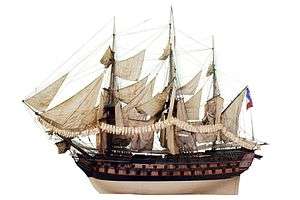French ship Ville de Berlin (1807)
Ville de Berlin was a Téméraire-class 74-gun ship of the line of the French Navy.
 Scale model of Achille, sister ship of French ship Ville de Berlin (1807), on display at the Musée national de la Marine in Paris. | |
| History | |
|---|---|
| Name: | Ville de Berlin |
| Namesake: | Berlin |
| Builder: | Antwerp[1] |
| Laid down: | April 1804 [1] |
| Launched: | 21 June 1807 [1] |
| Decommissioned: | 1817 [1] |
| General characteristics [2] | |
| Class and type: | Téméraire-class ship of the line |
| Displacement: |
|
| Length: | 55.87 metres (183.3 ft) (172 pied) |
| Beam: | 14.90 metres (48 ft 11 in) |
| Draught: | 7.26 metres (23.8 ft) (22 pied) |
| Propulsion: | Up to 2,485 m2 (26,750 sq ft) of sails |
| Armament: |
|
| Armour: | Timber |
Career
Ordered on 24 April 1804 as Thésée, Ville de Berlin was one of the ships built in the various shipyards captured by the First French Empire in Holland and Italy in a crash programme to replenish the ranks of the French Navy. She took her definitive name on 2 July 1807.[1]
She was commissioned on 21 September June 1807 and became a part of the Escaut squadron under Vice-Admiral Missiessy. In 1814, she took part in the defence of Antwerp.[1]
At the Bourbon Restoration, she was renamed Atlas and sailed to Brest. Renamed Ville de Berlin during the Hundred Days, she took her name of Atlas back after Napoléon's second abdication.[1]
Struck from the Navy lists on 23 February 1819, she became a storage hulk in Brest. [1]
Notes, citations, and references
Notes
Citations
- Roche, vol.1, p.467
- Clouet, Alain (2007). "La marine de Napoléon III : classe Téméraire - caractéristiques". dossiersmarine.free.fr. Archived from the original on 23 March 2013. Retrieved 4 April 2013.
References
- Roche, Jean-Michel (2005). Dictionnaire des bâtiments de la flotte de guerre française de Colbert à nos jours 1 1671 - 1870. p. 467. ISBN 978-2-9525917-0-6. OCLC 165892922.